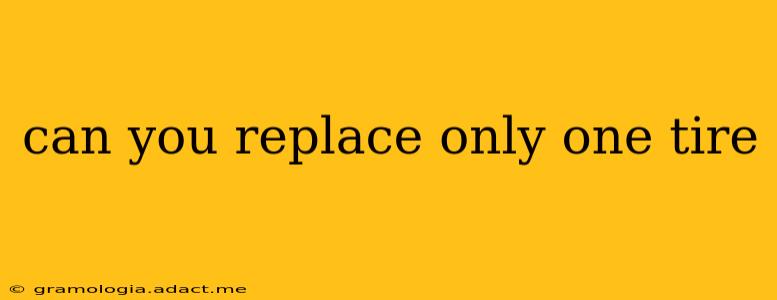Can You Replace Only One Tire?
Yes, you absolutely can replace only one tire. However, whether you should replace only one tire depends entirely on the situation. It's not always the best or safest option, and there are several factors to consider. Let's explore the nuances of this common question.
Why Would I Only Replace One Tire?
The most common reason to replace a single tire is because it's been damaged beyond repair – perhaps due to a puncture, significant sidewall damage, or a blowout. In such cases, replacing just the damaged tire is the logical and cost-effective solution.
When is Replacing Only One Tire NOT Recommended?
While replacing a single damaged tire is often fine, it's crucial to understand when it's not the best practice:
-
Uneven Wear: If only one tire is significantly worn compared to the others, replacing just that one is generally a bad idea. Driving with tires of drastically different tread depths can affect handling and braking performance, compromising safety. In this scenario, it's recommended to replace at least two tires—ideally, the two on the same axle (front or rear, depending on your vehicle's drive type). This maintains balanced handling and traction.
-
Tire Type Mismatch: Never mix tire types or brands on the same axle. Even if you have a spare, if it's a different type (summer, winter, all-season) or brand than the other tires on that axle, you'll risk instability. Tires are engineered to work together; mismatched tires can lead to unpredictable handling.
-
Tire Size Discrepancy: Using different tire sizes on the same vehicle can cause serious issues, from damage to your drivetrain to a loss of control. This is especially true if the difference is significant. Always ensure that all tires are the same size and type as specified in your vehicle's owner's manual.
What About Using a Spare Tire?
Using a spare tire is a temporary solution. Most spare tires are designed for limited use and may have different speed ratings and load capacities. Consult your owner's manual for the proper speed and usage restrictions associated with your spare tire. Once you've addressed the issue that necessitated using the spare, replace it with a full-size, matching tire as soon as possible.
What if I Have a Tire with a Slow Leak?
A slow leak can be patched or repaired, but if the damage is severe, a replacement is necessary. Don’t attempt to drive on a tire with a significant leak. It will put unnecessary stress on the tire sidewalls and could increase the risk of a blowout.
How Do I Know When to Replace a Tire?
Several factors indicate when a tire should be replaced:
- Tread Depth: Use a tread depth gauge to check the remaining tread. When the tread depth reaches 2/32 of an inch, it's time for replacement.
- Visible Damage: Look for cuts, bulges, cracks, or embedded objects in the tire sidewall or tread. Any of these can compromise the tire's integrity.
- Age: Even if a tire hasn't seen significant wear, age can degrade the rubber and compromise performance. Most tires are generally considered to be past their prime after six years, regardless of tread depth.
- Uneven Wear Patterns: Unusual wear patterns (such as feathering or cupping) can indicate alignment problems or other mechanical issues that should be addressed.
Replacing only one tire is sometimes the right solution, but it’s vital to understand the circumstances. Prioritizing safety and maintaining consistent tire performance across your vehicle is paramount. When in doubt, consult a professional tire technician. They can assess your tire condition and advise you on the best course of action.
